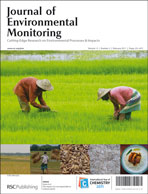Characterization of PM10-bound polycyclic aromatic hydrocarbons in the ambient air of Spanish urban and rural areas†
Abstract
Urban areas constitute major pollution sources due to anthropogenic activities located in these areas. Among the legislated air pollutants, the particulate matter with an aerodynamic diameter less than or equal to 10 microns (PM10) and polycyclic aromatic


 Please wait while we load your content...
Please wait while we load your content...